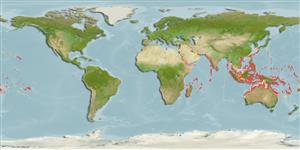Common names from other countries
>
Gobiiformes (Gobies) >
Gobiidae (Gobies) > Gobiinae
Etymology: Amblygobius: Greek, amblys = darkness + Latin gobius = gudgeon (Ref. 45335).
More on author: Herre.
Environment: milieu / climate zone / depth range / distribution range
Οικολογία
Θαλασσινό(ά) Υφαλόφιλο(α); εύρος βάθους 1 - 30 m (Ref. 86942). Tropical; 35°N - 28°S, 32°E - 143°W
Western Indian Ocean: Maldives (Ref. 30829) and the Red Sea and Arabian Gulf (Ref. 11441). Pacific Ocean: Philippines to the Tuamoto Islands, north to Yaeyama Islands, south to Rowley Shoals, southern Great Barrier Reef and Rapa; Guam and Kapingamarangi in Micronesia.
Μέγεθος / Βάρος / Age
Maturity: Lm ? range ? - ? cm
Max length : 10.0 cm SL αρσενικό/απροσδιόριστο; (Ref. 48637)
Short description
Κλείδες προσδιορισμού | Μορφολογία | Μορφομετρία
Ραχιαίες άκανθες (συνολικά) : 7; Μαλακές ραχιαίες ακτίνες (συνολικά) : 13 - 15; Εδρικές άκανθες: 1; Μαλακές εδρικές ακτίνες: 13 - 15. Characterized by having overall pale grey body color; head and body with pink stripes, most intense on head; dorsal fin base with row of 8-9 dark spots; first and second dorsal fin equal in height; slightly pointed caudal fin; longitudinal scale series 63-66; cycloid scales; head without scales; depth of body 4.7-6.4 in SL (Ref. 90102).
Solitary or in pairs (Ref. 90102). Common in areas with fine sand to muddy bottoms at the bases of inner lagoon and coastal reefs. Monogamous (Ref. 52884, 48637). Feeds on small invertebrates and organic matter (Ref. 89972).
Life cycle and mating behavior
Maturities | Αναπαραγωγή | Spawnings | Egg(s) | Fecundities | Προνύμφες
Monogamous mating is observed as both obigate and social (Ref. 52884).
Myers, R.F., 1991. Micronesian reef fishes. Second Ed. Coral Graphics, Barrigada, Guam. 298 p. (Ref. 1602)
IUCN Red List Status (Ref. 130435)
CITES (Ref. 128078)
Not Evaluated
Threat to humans
Harmless
Human uses
αλιεία: Εμπορικό(ά); Ενυδρείο: Εμπορικό(ά)
Εργαλεία
Special reports
Download XML
Διαδικτυακές πηγές
Estimates based on models
Preferred temperature (Ref.
115969): 25.1 - 29.3, mean 28.3 (based on 2853 cells).
Phylogenetic diversity index (Ref.
82804): PD
50 = 0.5000 [Uniqueness, from 0.5 = low to 2.0 = high].
Bayesian length-weight: a=0.01023 (0.00477 - 0.02194), b=3.02 (2.84 - 3.20), in cm Total Length, based on LWR estimates for this (Sub)family-body shape (Ref.
93245).
Τροφικό Επίπεδο (Ref.
69278): 3.0 ±0.2 se; based on size and trophs of closest relatives
Ελαστικότητα (Ref.
120179): Υψηλό, ελάχιστος χρόνος για διπλασιασμό πληθυσμού < 15 μήνες (Preliminary K or Fecundity.).
Fishing Vulnerability (Ref.
59153): Low vulnerability (10 of 100).
